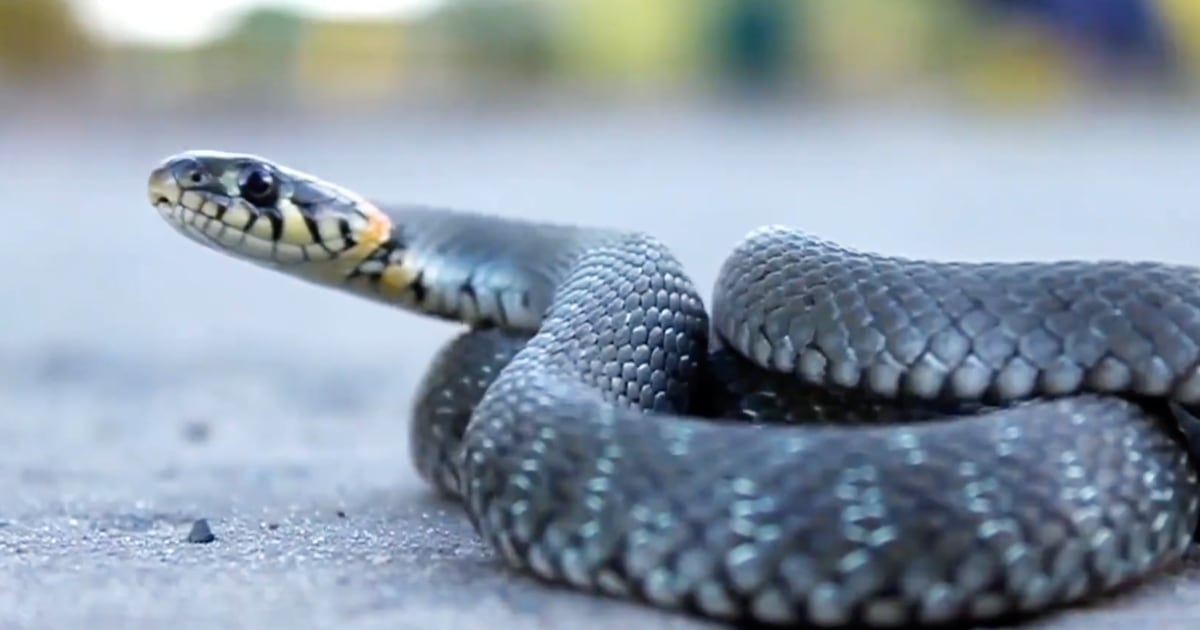
Sometimes, roads close because of rain. Sometimes, roads close because of snow. And sometimes, roads close because of snakes. Forest Road 345 in southern Illinois is one of them. The byway, which runs through Shawnee National Forest, is currently shut to accommodate a snake migration.
Twice a year, authorities prevent cars from traversing a 2.7 mile portion of this route to protect the migration of almost two dozen species of snakes, which biologist Steve Widowski told the St. Louis Post-Dispatch at one time looked like a heaving mass of spaghetti.
There are over 1 million collisions annually between drivers and large animals on American roads. These crashes take a dire toll: They kill 200 people each year and injure 26,000.
This Illinois forest is the only place in the U.S. where people can see a migration like this. But it’s common to come across other animals trying to cross the road (and not just chickens). Far too often, animals find themselves on streets that are open to traffic and end up being struck by vehicles — to the detriment of people as well as wildlife. Closing roads to protect wildlife can work for less-traveled routes like Forest Road 345, but there’s another option that can benefit human health, the economy and the environment all at the same time: wildlife crossings.
There are over 1 million collisions annually between drivers and large animals on American roads. These crashes take a dire toll: They kill 200 people each year and injure 26,000. Drivers in West Virginia have the greatest odds of hitting an animal, with a 1 in 37 chance of doing so every year. And the numbers aren’t a result of reckless driving; wildlife-vehicle collisions can happen simply when driving at a time and place in which animals are active.
Some types of accidents are especially deadly. Imagine you’re driving through the woods when a moose that’s taller than an NBA player steps out in front of your car so fast you can’t swerve. If you’re unlucky, your bumper will take out the moose’s legs before its body shatters your windshield — and then its 1,800 pound body hits you.
Thankfully, most wildlife-vehicle collisions do not involve moose. But smaller animals can still kill, injure or create major problems. Just ask the cement truck driver whose truck flipped onto its side after hitting an elk in Washington state last month. And just this weekend, a driver fatally collided with a deer in Michigan.
These crashes also come with a huge price tag. There’s the health care and automotive repair costs, and there are also expenses connected to the (all-but-guaranteed) death of the animal. An elk hit by a car leaves behind an unsightly, and possibly hazardous, carcass that authorities may have to spend money on to dispose of. Living animals also often have inherent economic value in their ability to attract tourists and hunters, which is lost when they become roadkill. A 2008 report put the total annual cost of wildlife-vehicle collisions at $8.4 billion.
Which brings us to wildlife crossings. Wildlife crossings are structures that allow animals to cross roads safely, in some cases reducing wildlife-vehicle collisions by 95%. Crossings can be tunnels or viaducts that pass under roadways or bridges that span highways, and fences are erected that funnel wildlife away from roads and through these passage points. Different types of animals seem to prefer different types of crossings.
Wildlife crossings can obviously help large animals like deer and bears, but they also benefit smaller animals like turtles and frogs that take longer to cross roads and are often missed or ignored by drivers because they are small, and to my knowledge no one has ever been killed by driving into a salamander.
Wildlife crossings also help connect populations of animals that would otherwise be separated by “asphalt rivers” allowing animals to cross roads they would avoid because of traffic. When animal populations are small and isolated, they are at much higher risk of extinction because they can get cut off from food or mates. Wildlife crossings potentially save money that would otherwise need to be spent to increase their numbers if we want to stave off extinction.
These crossings’ costs vary depending on the type, but all are expensive. Price tags range from $500,000 for an underpass to $6 million for a large bridge, so it’s important to put them where animals will use them, to select the most effective type for the animals in the area and to funnel animals toward the crossings with fencing along the road.
Still, the money saved by preventing just a few crashes a year means they can lead to net savings of hundreds of thousands of dollars every year. And they’ve been supported by state governments with very different political makeups: the Wyoming Game and Fish Department and the Washington State Department of Transportation both speak of their benefits.
People sometimes joke about why the chicken crossed the road. But perhaps more important is how the chicken (or the deer, elk, moose or bear) crossed the road — hopefully via an animal crossing.
Source: | This article originally belongs to Nbcnews.com










